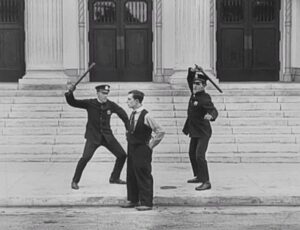
A year after the man dubbed the “Insane Clown President” by Matt Taibbi was voted out, Trump-era dread still haunts the USA.
As the end of October approached, numerous news outlets debunked online rumors that “clowns are allegedly planning their own purge the night before Halloween.” Yet while madcap maniacs’ mayhem was conspicuous in its absence, so was skeptical scrutiny of the similarly apocalyptic anxieties over the off-year elections of November 2.
When the forerunners of 2021’s clown warnings circulated in 2016, Mad magazine noted that common features with the concurrent presidential campaign included “men wearing makeup and disturbing grins” and being “like something out of a horror story.” If anything, such comparisons are too flattering to the political circus.
The campaign trail’s rivalries are more obnoxious than the one between Crazy magazine mascot Obnoxio the Clown and Mad‘s Alfred E. Neuman, who himself became a clown rather than merely clownish on the cover of Mad Clowns Around. Insane Clown Posse is not the threat to civil society that the FBI’s classification of the fanbase of the horrorcore hip hop duo as a gang itself became.
Election results confirming the Pew Research Center’s report that “support for reducing spending on police has fallen significantly” likewise reflect the premise of the Purge films (the second was subtitled Anarchy) that the absence of law and order would lead to chaos. Yet as Howard Zinn observed half a century ago, a society where “order based on law and on the force of law” preempts “harmonious relationships” and nonviolent settling of disputes “is the closest to what is called anarchy in the popular mind — confusion, chaos, international banditry.”
In an interview for their July 1976 issue, Karl Hess told Playboy magazine that “the Presidency could be overthrown tomorrow if the American people suddenly began laughing at it, or ignoring it” and that there was no need to “reach for the musket if all you need is a custard pie.” Looking back on that same bicentennial year’s presidential race for Vanity Fair, Wavy Gravy recalled that he was considered “too weird to arrest” when a bulge in his pocket turned out to be from gag teeth rather than a firearm, with the jester-protester choosing to follow its chattering rather than that of the candidates since “nobody should have that much power.”
Voting with one’s feet without passing through a polling site can be an effective path to change, even if those feet are wearing clown shoes.
New Yorker Joel Schlosberg is a senior news analyst at The William Lloyd Garrison Center for Libertarian Advocacy Journalism.
PUBLICATION/CITATION HISTORY
- “Was it a Clown Car or a Cop Car I Saw?” by Joel Schlosberg, CounterPunch, November 5, 2021
- “Was it a clown car or a cop car I saw?” by Joel Schlosberg, Miles City, Montana Star, November 5, 2021
- “Was it a Clown Car or a Cop Car I Saw?” by Joel Schlosberg, OpEdNews, November 10, 2021
- “Was it a Clown Car, or a Cop Car I Saw?” by Joel Schlosberg, Roundup Record-Tribune & Winnett Times [Montana], November 10, 2021


